Remember that old movie where the untamed maverick becomes a champion racehorse?
Tom Doak is currently starring in a modern-day golf version of that story. After 20 years of marching to the beat of a different drum, Doak has joined Tom Fazio, Pete Dye, Jack Nicklaus and Arnold Palmer among the most sought-after golf course designers in the world.
Yet, he still marches to his own beat.
Doak’s love for the game was born from tagging along with his high-handicapper dad on business trips – and he hasn’t stopped traveling since. He decided early on – in his teens – that he wanted to design golf courses and went to Cornell University in Ithaca, N.Y., to study landscape architecture.
His life changed considerably in 1982 when – with the support of Ben Crenshaw and others – he won a scholarship to live and caddie at St. Andrews. There, he spent his work days looping at the Old Course and, in his spare time, visited the other legendary links in the area.
Doak’s second lucky break came after several years of persistently nagging Pete and Alice Dye for a job. Dye finally called him out of the blue and told him he could work on the construction crew for them if he could start the next day. He jumped at the chance and, at the ripe old age of 20, began his real career in the glamorous field of golf course architecture with a shovel in his hands and mud on his boots.
For the newly minted Cornell alum, working for Dye was his “graduate school” in golf course design. He earned his “master’s” at age 26 with his first design, High Pointe Golf Club in Williamsburg, Mich., and more than a decade later achieved his design “doctorate” with the opening of Pacific Dunes – a course many hail as a modern masterpiece of minimalism.
Today, at age 45, Doak – inevitably accompanied by one or two of his eight associate designers – is still getting muddy tromping around sites from Oregon to New Zealand to the chic Hamptons, where he and his unlikely collaborator, Jack Nicklaus, just completed Sebonack Golf Club. I caught up with him at his offices in Traverse City, Mich., just before a visit to a new site in Scotland and the grand opening of the much-anticipated Sebonack Golf Club.
What’s your schedule like in terms of new projects, remodeling and consulting?
As we’ve gotten busier with new projects, I’ve tried to work my way out of most of the consulting. Some of my associates still do it, which is great because they get to work on some tremendous old courses. I still get involved with some greens rebuilding, like the three holes we redid at San Francisco Golf Club.
We’re doing three new courses a year, give or take. So I’m usually making visits to three construction sites, planning three for next year and looking for the next three for the year beyond that. I’m seldom home for more than 10 days at a time and seldom gone for more than two weeks.
What’s the scoop with the master planning craze? Is it healthy or just something clubs feel they need to do?
Tough question. Our interest in it is to work with great clubs and preserve what they have or to reclaim what they once had and kind of lost. Not nearly every club merits that approach. Some just aren’t that great. There’s also a restoration kick going on that’s based on clubs thinking it’s cool … and indirectly it’s a marketing thing. The old designer is suddenly famous, and the club is proud of it. The funny thing is that, 20 years ago, members at the same club would have just shrugged if someone mentioned that their course was designed by Tillie or Ross or MacKenzie.
Back to your question, I’m always a little skeptical of master plans. Most of the clubs that have called us in to consult were working off some else’s master plan. Writing something down that’s supposed to last a lifetime really doesn’t work.
You got your big break working for Pete Dye. How did that happen?
When I was 18 and decided to do this for a living, I wrote letters to a dozen architects and only got replies from a couple – Geoff Cornish and Alice Dye. The letter Alice sent me wasn’t a roadmap, but she gave me a lot of good advice and wished me good luck. Then, the summer of my junior year at Cornell, Dye called, and I got a chance to work on construction at Long Cove in Hilton Head, S.C. I’ve been in the business ever since.
I read somewhere that Pete taught you construction is inseparable from design. What’s that mean?
From the day I started working for Pete, I was rarely ever paid by Dye Designs. I was part of the construction crew and was paid by the contractor or course. Pete was always there at 6:30 a.m. with the crew, out in the dirt, making directions and figuring things out. In many architects’ offices, somebody draws the plans, and someone else goes out and builds it. Pete was different – he knew that building was just as important as blueprints – and I sort of modeled my company after that. I learned you can design better in 3-D than on paper.
Tell us something we don’t know about Pete Dye.
When I worked for Pete, he had the reputation that he was all about railroad ties. During the time I worked for him, he went five or so years when he didn’t use them at all … and nobody noticed.
You’ve also said you admire the work of Ben Crenshaw and Bill Coore. What’s special about them?
I knew both of them before they knew each other. Ben wrote a four-page handwritten letter to help get me the internship at St. Andrews. They really pick their projects and do fantastic work. Actually, the greatest thing for my career is that they don’t want to be busier.
Is Ben Crenshaw one of the best things that ever happened to golf?
He’s given so much of his time to so many people just because they were interested in golf at some level. It probably took away from his career. He would have won more events on the Tour if he hadn’t been so generous with his time with guys like me.
Define “minimalism” in golf course architecture.
I don’t want to define it anymore. The foundation of my style is trying not to make the design and construction process any harder than it needs to be. There are so many complicated things being done to shape the land. The more things you have to modify, the harder it is. The more things you change, the more things that can fail. I like to keep it simple and work with the land we have. My ultimate goal is to make our courses look like they’ve been there forever.
How much consideration do you give to maintenance in the design process?
The less you have to strip and return soil, the healthier the course is going to be. The only criticism we’ve had from a maintenance standpoint is that sometimes we’re in a hurry to start shaping, and we don’t clean up as well as we should before grow-in.
We’ve been lucky to work on a few projects in which the superintendent was there from day one and had input. That’s great for us. It eliminates potential problems up front.
You’ve worked side-by-side with superintendents for two decades. What separates the good from the great?
The other thing is they’re out on the course a lot. The really good guys don’t want positions when they’re not actually out there enough to really keep in touch with the course.
It used to drive Pete nuts that all the best superintendents we worked with wanted to get into construction. It’s ironic that, as an architect, you want the best person possible on site during construction, but then you want them to stay. After the superintendent at one of your courses changes five or six times, they might not have a clue what you intended.
What’s your advice to a young person who wants to get into the architecture business?
To get involved in design, get involved in construction first. You’ll be more valuable. There are a ton of people in landscape design schools or turf schools, and they have to separate themselves from the pack. Knowing the building process is the best way to do that.
Your writing really helped your career take off. Now there are other architecture writers getting involved in design. What should they know that you learned from the process?
Many people knew me as a writer first. It’s easier to find an editor to pay you to write than it is to find an owner who’ll pay you design a course. But, even though I wrote a lot, from the time I was 20, I was already working construction. The writing was always a sidebar. The architecture critics are mainly design consultants, and that’s great, but they need time in the field. You’re only going to get good if you actually go out and do it.
Is it a conflict of interest for a critic to compete against the people he criticizes?
It’s only a conflict of interest if the reader doesn’t know that somebody’s who’s writing an article also is on someone’s payroll.
Rumor has it you might publish an updated version of your most famous book, “The Confidential Guide to Golf Courses.”
The Confidential Guide sold 12,000 copies, but it’s difficult to find a copy. I get letters all the time requesting copies, and I wish I could supply them, but I can’t. But, if I republish it, I open the whole can of worms again. I’d have to answer a million questions about my motives.
Did any club member or another architect ever take a swing at you for being too candid about their course in your book?
I’ve gotten plenty of letters about it, but nobody’s ever gotten in my face.
I have an uncorrected proof copy of your first book, “The Anatomy of a Golf Course,” that you sent to me in 1991. Should I put it on e-Bay and make some big bucks?
If you do and it’s worth something, let me know. I still have a few of those around.
You’re probably the most famous and successful designer who isn’t a member of the American Society of Golf Course Architects. Why?
I’ve never applied. That doesn’t mean I have a problem with the Society, I just haven’t applied. I’m not much of a joiner.
When do you turn down a project?
One of the hardest parts of the business is when you’re trying to stay small and you have to decide which projects to do. You have to factor in how likely it is to actually get built, when it’s going to happen, etc. Those are tough questions if you’re committed to doing only a handful of projects. So, usually you don’t turn it down, you just don’t pursue it very hard. It’s funny now … with some developers, the more I say ‘no,’ the more they want me.
Have you reached the point where you choose the client you’d like to work with or a piece of land you’re really drooling over?
It’s a combination. If you see a great piece of land, you might overlook red flags about the client. But, at the same time, we’re looking for cool people that are fun to work with. Partly it’s land and also where we want to work. We’d love to do something near the Great Lakes. Heck, I haven’t worked within 200 miles of my house in 15 years.
Everyone’s made mistakes on specific projects or in their career paths. What would you have done differently or fixed?
I also didn’t learn enough about how to pursue work. Pete just waited for the phone to ring, and we pretty much do that, too. It probably would have helped me a lot 10 years ago if I’d known more about how to sell myself.
What was it like working with Nicklaus on Sebonack?
When I first heard about it, I said I would consider it, but doubted he would. I don’t think Jack would have done it if owner and Nicklaus friend Michael Pascuzzi hadn’t suggested the idea of collaborating. It worked out better than most people expected.
First, my early role was to do some of the things that Jack doesn’t do like the routing plan, etc., that some individual in his office would have normally done. Then out in the field, the only difference was that he listened to my view of things instead of just deciding himself. We agreed early on to come to an understanding about how to work together and didn’t have any problems.
It’s weird – and it’s probably true for Jack, too – that it’s the only golf course either of us have ever done that isn’t 100 percent ours. It’s a compromise course, but sometimes compromise works. Also, it was a great piece of land. We both wanted to do it. Places like that don’t come along often.
What does the average golfer not understand about your business?
The associate designers don’t get enough credit for what they contribute. We have a bunch of creative people spending a lot of time on every project. I usually have at least one associate on the ground at a site 25 days out of a month. I encourage them to go out and play around with the shape of green and build something good. That kind of collaboration has been great for us. I’ve gotten to be a better architect the more I’ve gotten away from trying to do everything. That’s because of them.
For 15 years, you were the “iconoclastic alternative” to big-name architects. Now you are one. How’s it feel?
It’s a little strange. Most of the potential clients that used to call me knew a few of my courses and weren’t scared off by the idea that I was iconoclast. Pacific Dunes changed that.
Now I worry that some people who contact me now have different expectations. Much of the signature design business is based on the fact that clients are comfortable you’ll build something similar to what you’ve done before. But I’ve always approached every project as a brand new challenge. We’re not going to build everything as a replica of Pacific Dunes or any other course. We take one approach – it’s the “we-don’t-know-what-we’re-going-to-do-yet-but-trust-us-it’ll-turn-out-good” approach.
How’s that working out?
Not bad. Not bad at all. GCN
Get curated news on YOUR industry.
Enter your email to receive our newsletters.

Explore the September 2006 Issue
Check out more from this issue and find your next story to read.
Latest from Golf Course Industry
- Beyond the Page 65: New faces on the back page
- From the publisher’s pen: New? No way!
- Indiana course upgrades range with synthetic ‘bunkers’
- Monterey Peninsula CC Shore Course renovation almost finished
- KemperSports and Touchstone Golf announce partnership
- PBI-Gordon Company hires marketing manager Jared Hoyle
- Mountain Sky Guest Ranch announces bunker enhancement project
- GCSAA names Joshua Tapp director of environmental programs





